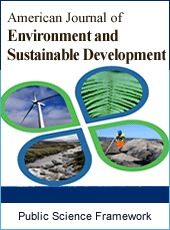American Journal of Environment and Sustainable Development
Articles Information
American Journal of Environment and Sustainable Development, Vol.5, No.1, Mar. 2020, Pub. Date: Feb. 20, 2020
Assessment of Heavy Metal Distribution and Concentration in Mining Sites (Du and Zawan) in Jos, Nigeria
Pages: 6-11 Views: 1804 Downloads: 408
[01]
Agboola Christianah Kemi, Department of Chemistry, Federal University of Technology, Akure, Nigeria.
[02]
Abata Emmanuel Orimisan, Department of Chemistry, Federal University of Technology, Akure, Nigeria.
[03]
Ogunyemi Olusayo Joseph, Department of Chemistry, Federal University of Technology, Akure, Nigeria.
[04]
Adebayo Albert Ojo, Department of Chemistry, Federal University of Technology, Akure, Nigeria.
Many human activities have led to the release of different environmental challenges and these challenges have direct or indirect contact with man which has deteriorating effects on all living organisms. Mining activities, though a process involving a natural deposit yet it gives rise to the non-biodegradable nature of heavy metals which persist for a long time in soil and interfere with normal metabolic activities of the living organism. Mining activities have to do with extraction, beneficiation, and processing of minerals. The purpose of this study was to assess the concentration of heavy metals in abandoned mined sites around Du and Zawan in Jos South local government. A total of 30 soil samples were collected from the site at depth 0 to 15cm and two (2) common plant produce were collected for this study. The samples were subjected to standard methods for pH determination, soil electrode potential, Cation Exchange Capacity (CEC), sequential extraction analysis and the heavy metals were analysed using an Atomic absorption spectrophotometer. The statistical analyses were conducted using one-way analysis of variance. The pH of the Du and Zuwan site is 5.33±0.09 and 5.43±0.02. CEC of the soil samples in Du and Zawan is 6.31±0.11 and 6.47±0.10 respectively. The soil electrode potential and the pH shows the soil carbon persistence and gives information on the presence of chemical compounds needed by the soil for growth, especially in most organic soil and this was observed to be lower in Du and Zawan when compared to the control site.
Heavy Metals, Contamination, pH, Concentration, and Mining Sites
[01]
Daniel, V. N, Chudusu, E. S., Chup, J. A and Pius, N. D. (2014). Variations of heavy metals in agricultural soils irrigated with tin water in Heipang district of Barkin Ladi, Plateau State, Nigeria. International Journal of Science and Technology, 3 (5): 255-262.
[02]
Scokart, P. O., Meeus-verdinne, K. and De Borger, R. (1983) Mobility of heavy metals in polluted soils near zinc smelters. Water, Air Soil Pollut, 20, 451–463.
[03]
Fadiran, A. O., A. T. Tiruneh, and J. S. Mtshali, 2014. Assessment of mobility and bioavailability of heavy metals in sewage sludge from Swaziland through speciation analysis. Am. J. Environ. Protect., 3: 198-208.
[04]
Pruvot, C, Douay, F, Hervé, F, Waterlot, C. (2006). Heavy Metals in Soil, Crops, and Grass as a Source of Human Exposure in the Former Mining Areas. J Soils Sediments 6 (4) 215-220.
[05]
Michael Adejare Adegboye (2012). Effect of mining on farming in Jos South Local Government Area of Plateau State. Journal of Soil Science and Environmental Management Vol. 3 (4), pp. 77-83 DOI: 10.5897/JSSEM11.048.
[06]
Abidemi, O. O., and Theresa, O. C. (2015). Environmental Fate of Heavy Metals in Soil of Ido- Osun Waste Dump Site, Osogbo, Osun, Nigeria. American Journal of Environmental Protection, 3 (1), 1-4.
[07]
Gungshik, J. R., Lohdip, Y. N., and Bewarang, E. S. (2007). Speciation of Trace Metals in Top Soils in Jos Industrial Areas.
[08]
Inengite, A. K., Abasi, C. Y., and Walter, C. (2015). Application of pollution indices for the assessment of heavy metal pollution in flood-impacted soil. Int. Res. J. Pure Appl. Chem, 8 (3), 175-189.
[09]
Jackson, M. L. (1967). Soil Chemical Analysis. Prentice-Hall of Indian Pvt. Ltd., New Delhi, p. 498.
[10]
Tessier, A., Campbell, P. G., and Bisson, M. (1979). Sequential extraction procedure for the speciation of particulate trace metals. Analytical Chemistry, 51 (7), 844-851.
[11]
Brady NC, Weil RR (1999). Soil organic matter. In: The Nature and Properties of Soils. Upper Saddle River, New Jersey, pp. 446–490.
[12]
Gebreyes G (2019). Soil Organic Matter and its Role in Soil Health and Crop Productivity Improvement. Acad. Res. J. Agri. Sci. Res. 7 (7): 475-483.
[13]
Anju, M.; Banerjee, D. K. Comparison of two sequential extraction procedures for heavy metal partitioning in mine tailings. Chemosphere 2010, 78, 1393–1402.
[14]
Adewuyi G. O. and Osobamiro M. T., 2016. Chemical Speciation and Potential Mobility of Some Toxic Metals in Tropical Agricultural Soil. Research Journal of Environmental Toxicology, 10: 159-165.
[15]
Brumer, G. W.; Gerth, J.; Herms, U. Heavy Metal Species, Mobility and Availability in Soils; Bodenk, Z. P., Ed.: Wiley-VCH Verlag GmbH & Co. KGaA: Weinheim, Germany, 1986.
[16]
Asmoay, A. S. A., Salman, S. A., El-Gohary, A. M., Sabet H. S. (2019). Evaluation of heavy metals mobility in contaminated soils between Abu Qurqas and Dyer Mawas Area, El Minya Governorate, Upper Egypt. Bull Natl Res Cent 43: 88. https://doi.org/10.1186/s42269-019-0133
[17]
Wuana, R. A and Okieimen, F. E. (2011). Heavy Metals in Contaminated Soils: A Review of Sources, Chemical, Risks and Best Available Strategies for Remediation. International Scholarly Research Network, 1-20.

ISSN Print: Pending
ISSN Online: Pending
Current Issue:
Vol. 6, Issue 4, December Submit a Manuscript Join Editorial Board Join Reviewer Team
ISSN Online: Pending
Current Issue:
Vol. 6, Issue 4, December Submit a Manuscript Join Editorial Board Join Reviewer Team
| About This Journal |
| All Issues |
| Open Access |
| Indexing |
| Payment Information |
| Author Guidelines |
| Review Process |
| Publication Ethics |
| Editorial Board |
| Peer Reviewers |


